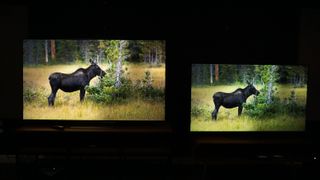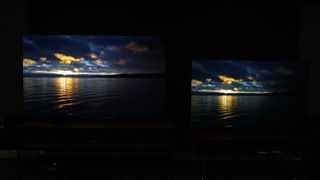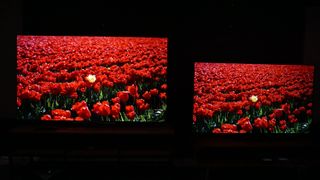If you're thinking of updating your TV, the world of OLED displays has probably intrigued you. OLED technology is common among the best TVs, often delivering the best picture quality on the market thanks to deep black levels, punchy color and stunning contrast. But, when you look at the OLED TV market, brands like LG, Samsung, Sony and so on often have multiple OLED models available, which on paper have differences on their spec sheets, such as better processors, higher brightness, more gaming features and so on. These are often to justify the bigger ranges in price.
TVs such as the Samsung S95C, LG G3 and Sony A95L are considered to be more premium OLEDs, with prices ranging from $1,899-3,000 / £1,899-3,000 / AU$3,500-5,300 for a 55-inch at the time of writing and depending on the model (with the Sony A95L being the more expensive of the bunch). These TVs are some of the best OLED TVs around and, arguably, that’s ever been released so far.
Naturally, you would assume then that more mid-range or cheaper models like the LG B3 (the entry-level OLED of LGs’ 2023 lineup), the LG C3, Sony A80L and Samsung S90C –the prices of which range from $1,100-1,500 / £1,100-1,600 / AU$2,495-2,995 – will lack the features that these more premium models have. This can range from better processing, picture quality, gaming performance and so on. Well, this isn’t the case because the gap between these TVs is narrowing.
I tested the LG G3 and LG B3, the premium and entry-level OLED TVs, respectively, of LGs 2023 lineup and got to see how the two compared when next to each other and playing the same source at the same time (using a 4K/60Hz HDMI splitter). I got to really see the differences between the two – and the results were surprising.

One fundamental difference between the G3 and B3 when viewing them at the same time was the overall brightness. The LG G3 has micro-lens-array (MLA) technology, which is said to boost brightness by 150% compared to the brand’s 2022 models, and this was noticeable. Highlights of colors and brighter scenes involving daylight were definitely much brighter on the G3 than the B3. In fact, in many OLEDs, this does tend to be the case in my experience.
With the introduction of QD-OLED, which uses quantum dot technology that Samsung has in its QLED TVs to boost brightness levels and sharpen whiter colors paired with OLED panels, by Samsung in 2022 – the panel of which is used in the Samsung S95B – OLED contrast and black levels were paired with the brightness of QLED to combine and create the best of both worlds. This was really perfected when Samsung released the S90C and S95C in 2023. Both had stunning levels of brightness, but the S95C was a full 300 nits brighter than the S90C, which you would expect from a more premium model.

But, when it comes to black levels and contrast, and even color, the line begins to blur. When viewing a demo reel footage of various landscapes, including city nightscapes and snowy woodlands, both the LG G3 and LG B3 demonstrated fantastic contrast and deep blacks. The B3 more than held its own against the G3. Yes, the G3 was naturally much brighter as expected with the MLA technology, but in terms of actual quality, the B3 demonstrated serious value.
With some of these cheaper OLEDs vs premium OLEDs, the difference isn’t always in the picture. The Sony A80L and Sony A95L (the latter of which uses a QD-OLED panel), despite being opposite ends of the price spectrum, use the same processor – the Cognitive Processor XR which means on paper again. These TVs deliver very similar performance, with the main factor being the QD-OLED panel of the Sony A95L vs the W-OLED panel of the Sony A80L. Where these TVs differ comes down to brightness and color range.
Performing artsWhile testing the LG G3 and B3, I was also able to compare their performance at the same time. Using the same HDMI splitter I’d used for the picture comparison, I was able to test the LG G3 and B3’s gaming performance while playing Battlefield V, a First-Person-Shooter (FPS). I was amazed at how similar they were, not only performance wise but graphically. Fast panning between targets and around the environment looked smooth on both screens. When I measured the input lag, while in Boost mode in the LG Game Optimizer, they were both 9.2ms. So for gaming, these two TVs were nearly identical.
Image 1 of 2 The LG G3 (pictured) is graphically impressive (Image credit: Future)
The LG G3 (pictured) is graphically impressive (Image credit: Future) The LG B3 (pictured) is as equally graphically impressive as the LG G3(Image credit: Future)
The LG B3 (pictured) is as equally graphically impressive as the LG G3(Image credit: Future)In general, this seems to be the case with a lot of OLED TVs, regardless of price. Gaming performance may improve marginally in the more premium OLEDs, but cheaper OLEDs can still make excellent TVs for gaming. Thanks to more extensive game modes and menus being put onto all TVs, not just OLEDs, getting the best gaming experience out of a TV has become a lot easier.
When it comes to motion processing, you would expect more premium OLEDs to appear smoother during fast paced scenes with lots of panning shots or during sports broadcasts, but as long as a TV has a 100Hz/120Hz panel, it can generally handle motion to the same degree. When watching movies like Top Gun: Maverick with jets zooming across the screen or playing the fast-paced FPS Battlefield V, both the LG B3 and G3 handled any fast panning motions with ease.
I’m talking about moneyAs I mentioned above, prices on a 55-inch cheaper OLED vs a premium OLED seem to have a gap between them ranging from a $600/£700/AU$1,600 difference between the LG B3 and LG G3, all the way up to roughly $1,300/£1,400/AU$2,300 between the Sony A75L/A80L (the cheaper OLEDs) and the Sony A95L. This is a pretty substantial difference and with that extra money saved by going for a cheaper option, you could buy one of the best soundbars to compensate for the sometimes lacking sound you find on the cheaper OLEDs compared to the more premium OLEDs.
Of course, there are a couple of models that offer the best of both worlds based on value and performance. One in particular is the Samsung S90C. Although it is the ‘entry-level’ of Samsung’s 2023 QD-OLED lineup, it is more of mid to high-end range OLED akin to the LG C3 and Sony A80L, in the way it offers nearly everything its higher-end counterpart, the Samsung S95C, does other than brightness levels at a lower cost. This coincides with the two Sony’s, the A80L and A95L, having the same processor. This is also the case with the LG C3 and LG G3, meaning you can get the same level of performance, barring a few features, out of the mid-range OLED that you can in the premium.

What’s clear is that not only is the line blurring between what’s considered a cheaper OLED and what’s considered a premium OLED, but also what you can get out of these cheaper OLEDs, which is improving all the time. I recently said that the LG B3 is the dark horse of the OLED TV world and I really do believe that. Yes, it’s not the brightest TV but viewed in the right conditions, it really does have a picture that exceeds its price tag.
Of course, premium OLEDs do come with all the features and picture quality you could want. Whatever it is that is giving them the leg up, such as the MLA tech in the LG G3 or the QD-OLED panel in the Sony A95L vs the W-OLED panel in the Sony A80L, the more premium models come with all the bells and whistles. However, thinking back to TVs from several years ago, the gap doesn’t seem as large between budget and premium anymore.
TVs like the Samsung S90C, LG C3 and Sony A80L are providing the mid-range option that has become popular, as it provides nearly all the things you could want and need. It also saves you some cash along the way. But even the LG B3 is a worthy contender for your hard earned money, despite its entry-level nature. As OLEDs continue to evolve as well, who knows what we could see in the future – will the gap between premium and cheaper OLEDs close even more?
You might also likeI swapped my LG C2 for the LG G3LG B3 vs LG C3The time of regular OLED is over - make way for QD-OLED